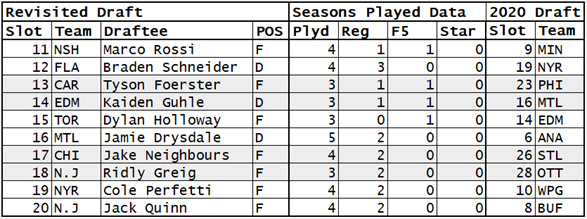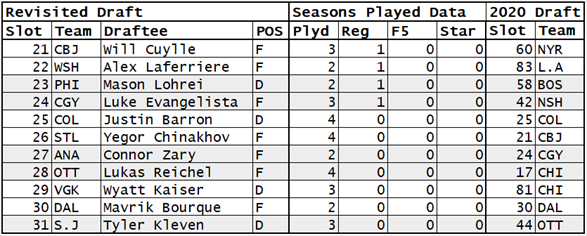It is summer, so it is an excellent time to make hockey-related lists. I’ve seen a list of the top 27 players under 27 (or something similar), a list of the top prospects at a certain position for a certain team, and a list of the top left-handed goalies who were born in Europe. And there have been some interesting videos coming from a league in Australia.
I’ll probably do a couple of list articles this summer, as it keeps me busy. I won’t do anything about the Australian hockey league, except to say that any league which ends up with a 5-on-3 power play in OVERTIME must be entertaining. Especially when the team, down two men, almost scores on a 2-on-1 breakaway while killing penalties.
In this article, I will show what the 2020 draft choices might have been, had all NHL teams had crystal balls that were tuned to the player ratings of Stapled to the Bench (STTB), and if all those teams thought that STTB’s ratings were reasonable.
In advance, I will ask for a little forgiveness for the spelling of some players’ names. I know that Stutzle is Stützle, and I know that Lafreniere is Lafrenière. But the software mix I use does not handle some accents very well, so I replace them with unaccented letters. Don’t get me started about the letter “ä”.
How Players Were Ranked to Determine Their Appropriate Draft Order
The main factor in determining the appropriate draft order for players was their PR-Scores in the five seasons since the draft (2020-21 to 2024-25). I added a couple of other things to reward players who have played excellently, even though they haven’t played all five seasons.
Players were awarded points based on their PR-Scores: two times the total of their PR-Scores, five times their highest PR-Score and three times their 2024-25 PR-Score. Players were awarded 10 points for each good season (a PR-Regular season) and 20 points for each great season (a PR-First5, PR-Star or PR-Elite season). The total of these items was called DRScore. For example, let’s use one of the top ten draft picks from 2020.

Drysdale’s low 2022-23 season was caused by playing only 8 games. He has not yet set the world on fire, but he’s still young: hope springs eternal.
Where does Drysdale’s DRScore put him with respect to his classmates? Where should he have been drafted?
The Top 31 Draftees From 2020
Drysdale’s DRScore of 93.95 ranks him 16th in the class of 2020.
There were 31 picks in the first round in 2020, so the top 31 players of the class are the players who “should have been” drafted in the first round. Here they are:

As a side note, the Class of 2020 is one of the weaker Draft Classes since 2007. STTB rates and ranks draft classes based on the PR-Scores the draftees generate over the first six post-draft seasons, so the exact positioning of the 2020 Class will only be known at the end of the 2025-26 season. All I can be sure of is that it will be one of the lowest-rated classes.
While it is a weak class, it does have some nice players. Stutzle has been a marvel, even though he has been struggling with an injury (according to his statistics) these last two seasons. Raymond, Sanderson and Jarvis are very good players: Sanderson could eventually be the best 2020 draftee.
Lafreniere has not produced at the level expected of a #1 pick. Unless he plays like peak Mika Zibanejad next season, he will end up with a below-average score for a player drafted with one of the top two picks. (Spoiler alert: he won’t play like peak Zibanejad next season.)
Draft Class Trivia
217 players (7 rounds, 31 players per round) were drafted in 2020, a number which includes goalies. Only 76 skaters from this class have played at any games in the NHL.
24 skaters had at least one season rated as PR-Regular or better. 14 skaters had PR-First5 or PR-Star seasons. No player from this class has had a PR-Elite season.
The 2020 Draft, Revisited
When STTB evaluates draft picks, players are placed in groups based on where they were drafted. The first round has five groups: picks 1 and 2; picks 3 through 5; picks 6 through 10; picks 11 through 20 and pick 21 through the end of the first round. I’ll present the revisited draft based on those groups.
We’ll start with the top of the draft (draft groups 1 and 2; the first five picks).

The revised order of drafting teams will be the 2020 order. The “revisited draft” section of the table shows which team would have picked which player, based on today’s knowledge. The “seasons played” section shows how many seasons each drafted player has played and how many of those seasons were PR-Regular, PR-First5 and PR-Star. The “2020 Draft” section shows where a player was drafted and by whom.
Ottawa won the 2020 draft, part 1: their picks at #3 and #5 gave them the 1st and 3rd best players in the draft. It must be noted that they won the draft more through good luck than through superior intelligence. Had Lafreniere or Byfield still been available at #3, Ottawa would have taken them: the pre-draft consensus was that the top three players available were #1 Lafreniere, #2 Byfield and #3 Stutzle.

I picked up a quote from a New York Times article that answered questions from readers. One reader asked about the 2020 #1 pick, Alexis Lafreniere. The writer said, “He does not seem like he’s going to be a superstar, which is what teams hope for when they have the No. 1 pick, but he is still only 23 and showed in 2023-24 that he can be a top-line-level player.” STTB had Lafreniere as a PR-First5 in 2023-24, which agrees with this sportswriter’s subjective evaluation, but he reverted to PR-Regular in 2024-25.
The reader asked whether Lafreniere would be a late bloomer or a #1 dud. That is not necessarily an either/or answer: he could be both. He’s presently a third-line talent, but he could improve. And even if he does improve, he won’t be PR-Elite player, so he’ll still be considered a #1 dud.
I feel a bit of sympathy for high draft picks that don’t become superstars. For their entire career, they wear the albatross of their draft slot. Had Lafreniere been drafted at #8 instead of #1, he’d be much more favourably regarded now. Whose fault is it that he was drafted #1? It wasn’t Lafreniere’s fault: it was the Rangers’ fault. But, as I mentioned earlier, every team in the NHL would have selected him if they had had the first pick.

Toronto used its #1 pick on Rodion Amirov, who unfortunately passed away at the age of 22 due to a brain tumour. F*** brain tumours.
Ottawa won the 2020 draft, part 2: Ridly Greig should have been picked at #18 by the Devils but was available for Ottawa at #28.

Ottawa won the 2020 draft, part 3: Tyler Kleven should have been picked at #31 by San Jose, but was available for Ottawa at #44.
Summary
Ottawa has gotten a lot of value out of the 2020 draft. Some of that should have been expected, as they had the 3rd and 5th pick, but they came away with the 1st and 3rd most valuable players from the draft: their results have exceeded their expectations. On top of Stutzle and Sanderson, they also got Ridly Greig and Tyler Kleven.
The Rangers had a good result and a bad result from their first two round picks. I have talked enough about #1 pick Alexis Lafreniere (8th most valuable 2020 draftee), so let me concentrate on their good result: Braden Schneider, drafted with the 19th pick, but is the 12th most valuable 2020 draftee.
The Rangers are 7-down with one pick (1st drafted, 8th best) and 7-up with another pick (19th drafted, 12th best), so does that make them even on the 2020 draft? No, they are not even close to even.
The expectations of a #1 pick (35 PR-Points over six seasons) are far higher than those of a #19 pick (9 PR-Points over six seasons), or even a #9 pick (14 PR-Points over six seasons). The drop from #1 to #8 is significant: a good estimate would be 17 PR-Points. The rise from #19 to #12 is small in comparison: I’d estimate it to be worth 5 PR-Points.
Related Articles
